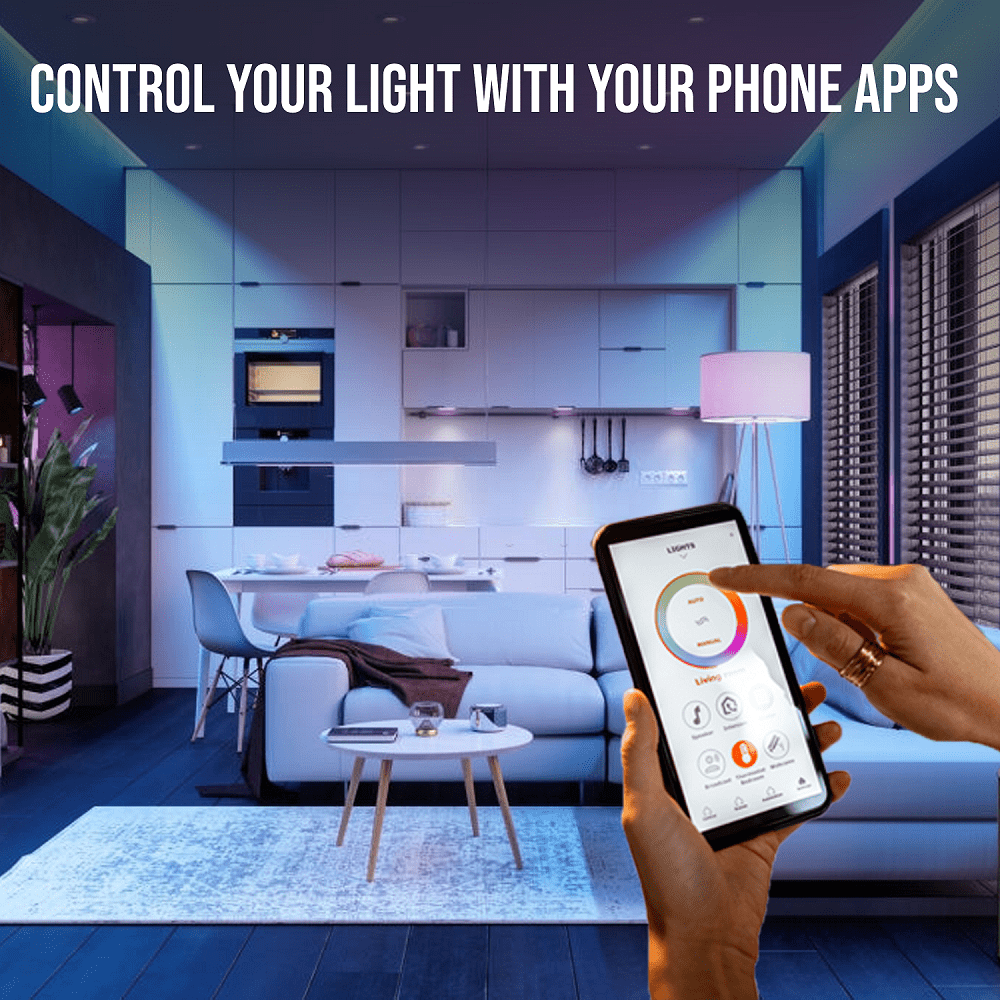In the past, controlling light bulbs with your voice or the simple clap of your hands was a science-fiction scenario. Now it became reality. Home lighting has made great strides by becoming more intelligent and adapting to the customer’s needs by facilitating technology and reducing capital investment.
Philips was the first to bring the Smart Home Lighting into the market with their Smart Bulbs (Philips Hue), setting the Smart Bulb standard for the company for several years to come. Eventually, but not surprisingly, Kamzai, like several other light bulb manufacturers has gotten into the Smart RGB industry.
Most of you may be wondering at this point; how much does it cost to build such a lighting system in my home? But let’s take it one step at a time and go in order. Let’s start by defining the precise meaning of intelligent lighting.
A Smart Bulb is a bulb that you can control and adjust directly from your smartphone.
How can we regulate them? Simple, thanks to an application developed by the manufacturers of the bulbs themselves. Through the app, you can set the brightness, and if the lights have different colors, we can also change their hue. In addition, you can also set standard brightness adjustments. Such as a light for reading, dim light for dinner, and a light to watch the movie on TV.
Among the companies that first invested in this Smart home sector, you find Philips Hue. But Lumive, Ikea, and many other companies have come into the field of smart bulbs. Most of you may be wondering at this point: how much does it cost me to build such a lighting system in my home? But let’s take it one step at a time and go in order. Let’s start by defining the precise meaning of intelligent lighting. A smart bulb is one that you can control and adjust directly from your smartphone.
How Smart Bulb works?
To install a network of smart light bulbs, you do not need to make significant changes. Just use the current home electrical system. The attachment for the chandelier is no different than the one usually used for the light points. In addition, each bulb is equipped with a wireless connector that allows it to communicate with the closest one. These connect to the home router.
The same router to which your smartphone also connected. Some led bulbs allow remote control as well. So even from the office, you can adjust the lighting of the exteriors or turn on the entrance lights as you get out of the car back home. Then there are special smart light bulbs that warn us in case of sudden changes in currents and thunderstorms and advise us, on the app, on the actions to be taken.
How is WiFi Smart Bulb controlled?
The operation is so simple. The bulb is screwed to the lamp holder; to replace an existing light bulb; and can be controlled, as always, with the switch.
When the current passes, the bulb can receive or emit signals; so it can be connected, depending on the model, to different solutions, such as:
- A smartphone, which allows you to control it via applications or with specific IoT protocols, such as Apple HomeKit and Google Assistant;
- A HUB is a control unit that controls the connections, which can be proprietary or compatible (this is the case of Amazon Alexa, with devices such as Amazon Echo Plus ); the advantage of the Hubs is the automatic and simultaneous control of several bulbs;
- A remote control, generally for less expensive bulbs that can be controlled with the appropriate device (from the remote control, you can increase/decrease the light or choose the color). This type, since it connects only with the remote control, is usually not defined as the smart bulb.
The control system (for example, an app) must be configured. But usually, the configuration is simple: the switched on RGB light bulb is automatically recognized, then a password is entered, or take a picture of a QR code to complete the configuration.
Smart bulb and artificial intelligence
To control the smart light bulbs, you can also use digital assistants, as well as the smartphone. Systems like Cortana, Siri or Alexa, and Google Assistant, with these tools, tell the personal assistant “dim the lights, or set the cinema mode, and the bulbs will receive your voice command.
What is a Smart Bulb?
There are three different models of Smart RGB lights. There are bulbs with standard bulbs, candle bulbs, and spotlights led. All Smart light bulbs use technology LED that consumes much less than the classical to glow. A standard smart light bulb ranges from 5.5W to 10W, which is almost equivalent to a 50-80W incandescent bulb. As mentioned, there are white or colored. Those that change color is more expensive.
Colors of the Smart bulbs
There are various types of Smart bulbs currently on the market, classified by lighting power, type of power connection, and connectivity.
The smart light bulb itself, however, can be more or less rich in features, and we can classify it as follows:
- Bulb with non-adjustable light tone: these are bulbs that emit light of a single color (warm or cold), which cannot be customized and have their own fixed shade. The Smart component allows you to turn them on and off remotely.
- Dimmable Hue Bulb: This is a white-like bulb whose light hue is adjustable from warm (yellow) to cool (blue).
- RGB colored light bulb; it is a light bulb equipped with red, blue, and green (RGB) LEDs. The switching ON/OFF of the individual LEDs allows you to obtain all the colors of the chromatic scale, thus allowing you to change the color of the bulb with the color you prefer.
- Dimmable bulb: it can belong to each of the earlier categories, and allows you to change the light intensity, using a specific device (physical or virtual, on a smartphone) called Dimmer.
How much do Smart light bulbs cost?
Let’s face it right away: Smart lighting systems are getting cheaper every day with the technology being accessible to more people, In the past, it was very costly to convert your lighting to smart ones, but recently this is no longer the case as you can get premium-quality smart bulbs with very affordable prices from Lumive Store.









